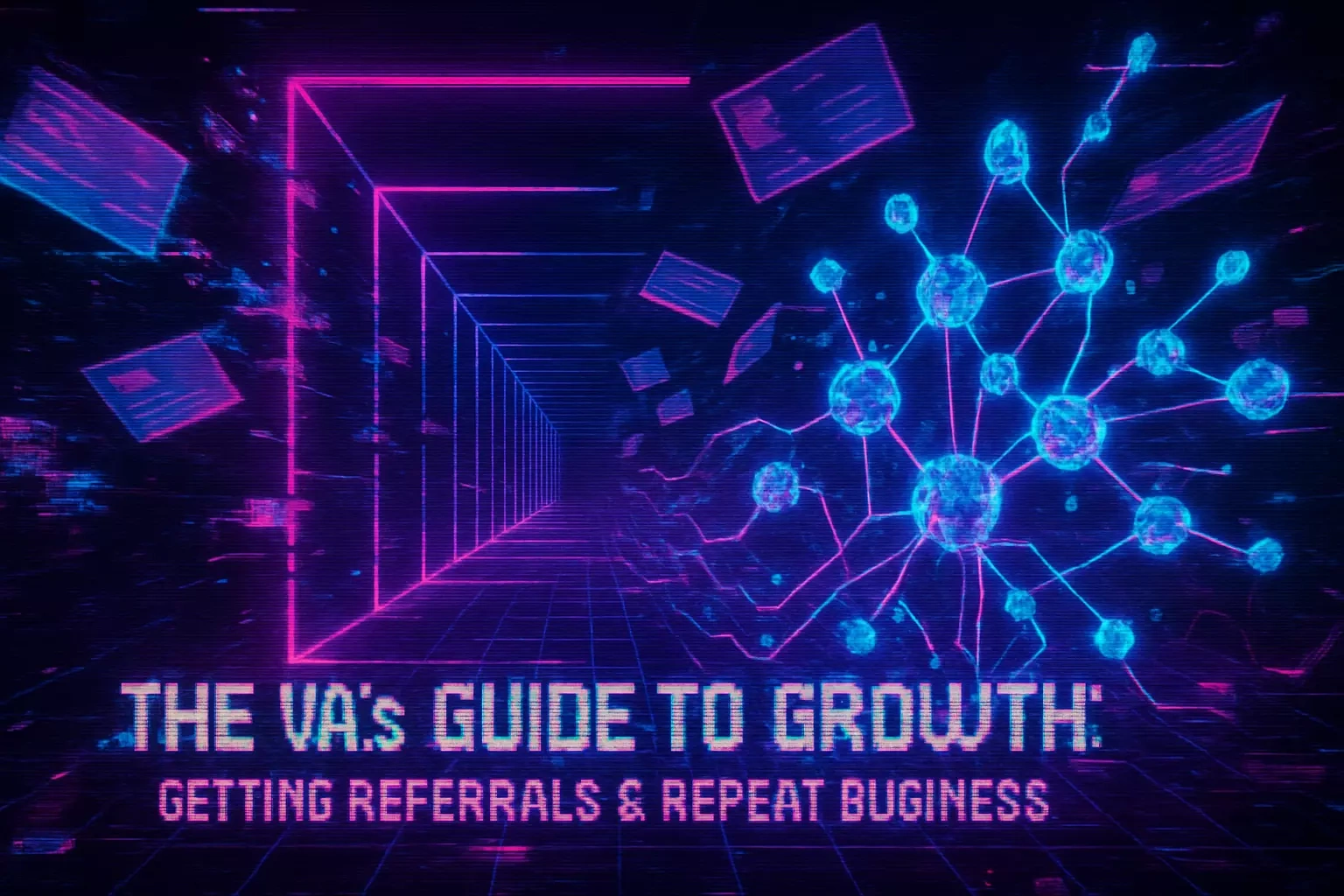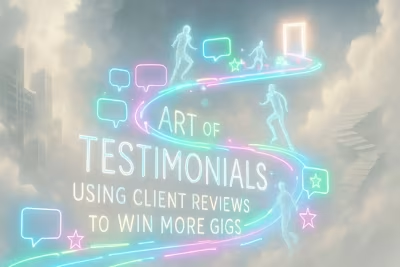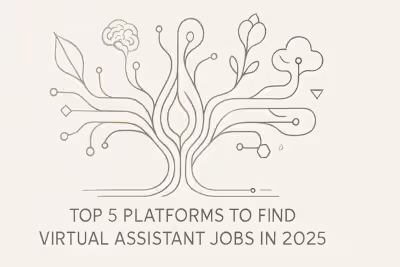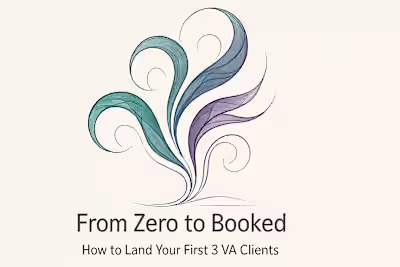The VA's Guide to Growth: Getting Referrals & Repeat Business

The VA's Guide to Growth: Getting Referrals & Repeat Business
The Foundation: Delivering an Unforgettable Client Experience
Mastering Proactive Communication
Setting Clear Expectations and Over-Delivering
From One-Off Project to Long-Term Retainer
Identifying and Proposing Ongoing Work
How to Frame the Benefits of a Retainer
Building a Simple and Effective Referral System
Knowing the Perfect Time to Ask
Making It Easy for Clients to Refer You
The Pros and Cons of a Referral Incentive
Staying Top-of-Mind with Past Clients
Conclusion
References
The VA's Guide to Growth: Getting Referrals & Repeat Business
The constant search for new clients is exhausting. The most sustainable way to grow your virtual assistant business is by focusing on the clients you already have. Acquiring a new customer can cost five times more than retaining an existing one, and increasing retention by just 5% can boost profits by 25-95%. This guide will show you how to provide an exceptional experience that leads to long-term retainers and a steady stream of referrals.
This approach builds on the momentum from landing your first clients and is powered by great testimonials. When businesses hire a virtual assistant, they're looking for someone who can become an integral part of their team. By focusing on retention and referrals, you'll build a sustainable business that grows naturally through word-of-mouth.
The Foundation: Delivering an Unforgettable Client Experience
Referrals and repeat business don't just happen by accident. They're the natural result of consistently exceeding expectations and making your clients' lives easier. When you deliver exceptional service, clients don't just stick around—they become your biggest advocates.
Think about it this way: every interaction with your client is an opportunity to strengthen your relationship. It's not about being perfect. It's about being reliable, thoughtful, and genuinely invested in their success. When clients feel valued and supported, they naturally want to continue working with you and tell others about their experience.
The key is consistency. One amazing week followed by three mediocre ones won't cut it. Your clients need to know they can count on you to deliver the same high-quality service every single time. This reliability becomes your calling card and the foundation of your reputation.
Mastering Proactive Communication
Most VAs wait for their clients to reach out with questions or concerns. But the truly exceptional ones? They're always one step ahead. Proactive communication is about anticipating needs before they become urgent requests.
Start by establishing a regular update schedule. Maybe it's a quick Monday morning email outlining what you accomplished last week and your priorities for the current week. Or perhaps it's a Friday wrap-up with completed tasks and any questions for the following week. The format matters less than the consistency.
Here's what proactive communication looks like in practice. Let's say you're managing your client's social media. Instead of waiting for them to ask about performance, send them a brief weekly report. Include what's working, what could be improved, and your recommendations for next steps. If you notice their competitor just launched a campaign, flag it immediately with your thoughts on how to respond.
When potential issues arise, address them head-on. Notice a deadline might be tight? Let your client know immediately, along with your plan to meet it or a request for prioritization. Spot an error on their website? Don't wait for them to discover it—send a quick message with the fix already implemented.
This approach transforms you from a task-doer to a trusted partner. Your clients will start to rely on your judgment and appreciate that you're looking out for their interests even when they're focused elsewhere.
Setting Clear Expectations and Over-Delivering
Nothing damages a client relationship faster than mismatched expectations. That's why crystal-clear communication from day one is non-negotiable. Before you start any project, document exactly what you'll deliver, when you'll deliver it, and how you'll communicate along the way.
Create a simple project brief that outlines the scope of work, specific deliverables, timelines, and communication preferences. Does your client prefer email or Slack? Do they want daily updates or weekly summaries? What's their preferred turnaround time for questions? Getting these details sorted upfront prevents frustration down the road.
But here's where the magic happens: once you've set clear expectations, look for small ways to exceed them. Over-delivering doesn't mean working for free or constantly expanding the scope. It means adding thoughtful touches that show you care about their success.
Maybe you finish a task early and use the extra time to organize their Google Drive. Perhaps you create a simple template that will save them time on future projects. Or you might share a relevant article or tool you came across that could help their business. These small gestures make a big impact.
One VA I know always includes a "bonus tip" at the end of her weekly reports—a quick suggestion for improving their processes or a heads-up about an industry trend. Another creates simple video walkthroughs when explaining complex tasks, making it easier for clients to understand and replicate the work if needed.
The goal isn't to give away hours of free work. It's to show that you're thinking beyond the task list and genuinely invested in making their business better. This mindset shift—from service provider to strategic partner—is what turns one-off projects into long-term relationships.
From One-Off Project to Long-Term Retainer
The most stable VA businesses aren't built on a constant stream of new projects. They're built on long-term relationships with clients who value your work month after month. Converting a single project into an ongoing retainer is one of the smartest moves you can make for your business stability.
Think about it from your client's perspective. They've just spent time onboarding you, sharing their preferences, and getting you up to speed on their business. If you've done great work, why would they want to start that process all over again with someone new? The key is helping them see the value in keeping you around.
The transition from project to retainer often happens naturally when you're delivering exceptional work. But sometimes you need to guide the conversation. The best VAs don't wait for clients to suggest ongoing work—they proactively identify opportunities and present solutions.
Identifying and Proposing Ongoing Work
As you work on any project, keep your eyes open for other areas where you could add value. This isn't about inventing work that doesn't exist. It's about noticing genuine opportunities to help your client save time, make money, or reduce stress.
Start keeping a simple document where you jot down ideas as they come up. Maybe you notice their email newsletters could be more consistent. Perhaps their customer service responses are taking too long. Or you spot opportunities to repurpose their content across different platforms. Don't interrupt your current work to mention every idea—instead, collect them for the right moment.
The best time to propose ongoing work is when you're about 75% through your current project. You've proven your value, but there's still time to discuss next steps before the project ends. Schedule a brief call or send a thoughtful email outlining what you've noticed.
Here's a framework that works: "While working on [current project], I've noticed a few areas where I could potentially help you save time and grow your business. Would you be interested in discussing some ideas I've had?" This positions you as a strategic thinker, not someone just fishing for more work.
When you present your ideas, be specific about the value you'll provide. Instead of saying "I could help with social media," try "I've noticed you're missing opportunities to engage with customers on Instagram. I could dedicate 5 hours per week to managing your account, which based on similar accounts could increase your engagement by 30% and drive more traffic to your website."
How to Frame the Benefits of a Retainer
Once your client shows interest in ongoing work, it's time to present the retainer option. Many VAs make the mistake of focusing on why a retainer is good for them—steady income, predictable schedule. But your client doesn't care about your cash flow. They care about their business.
Frame the retainer as a solution to their problems. Here are the key benefits to emphasize:
Guaranteed availability: With a retainer, they get priority access to your time. No more wondering if you'll be available when they need you. You're their dedicated VA, ready to jump in when urgent tasks arise.
Better integration: When you work together consistently, you become like an employee without the overhead. You'll understand their business deeply, anticipate their needs, and require less direction over time.
Cost predictability: Instead of variable monthly costs, they'll know exactly what to budget for VA services. Many businesses prefer this predictability for financial planning.
Proactive support: With a retainer, you can work proactively instead of reactively. You'll spot opportunities and solve problems before they're asked, adding more value than project-based work allows.
Present the retainer as an investment in their business growth, not an expense. Share specific examples of how ongoing support will help them achieve their goals. If they seem hesitant about committing to a large retainer, suggest starting small—maybe 10 hours per month—with the option to increase as needed.
Remember to make the terms clear and fair. Include what's covered in the retainer hours, how unused hours are handled, and how you'll track and report time. The clearer the agreement, the more comfortable they'll feel moving forward.
Building a Simple and Effective Referral System
Your happiest clients are walking advertisements for your business. They've experienced firsthand how you've made their lives easier, and they likely know other business owners facing similar challenges. But here's the thing: most satisfied clients won't think to refer you unless you ask.
Building a referral system doesn't mean being pushy or salesy. It means creating a simple process that makes it easy for clients to spread the word about your services. When done right, asking for referrals feels natural and actually strengthens your client relationships.
The secret is timing and approach. You want to ask when your value is most apparent and make the process as frictionless as possible. Let's break down exactly how to do this without feeling awkward or desperate.
Knowing the Perfect Time to Ask
Timing is everything when it comes to referral requests. Ask too early, and you haven't proven your value yet. Wait too long, and the excitement about your work may have faded. The sweet spot? Right after a win.
Pay attention to these golden moments:
When a client sends you glowing feedback
After you've completed a major project milestone
When you've solved a particularly tricky problem
During your regular check-in when they mention how much time you've saved them
After they've renewed their retainer or expanded your responsibilities
Here's what this looks like in real life. Your client emails: "Wow, the new system you set up is saving me 5 hours a week! I can't believe I didn't do this sooner." This is your moment. Respond with genuine appreciation, then add something like: "I'm so glad it's making such a difference! If you know any other business owners who could use similar support, I'd be happy to help them too."
The key is to make it conversational, not transactional. You're not demanding referrals as payment for good work. You're simply letting them know you have capacity to help others in their network.
Another approach is to build referral conversations into your regular rhythm. During monthly check-ins, after reviewing what you've accomplished, you might say: "I really enjoy working with you and have some availability for one or two similar clients. If you know anyone who might benefit from VA support, I'd appreciate an introduction."
Making It Easy for Clients to Refer You
Even when clients want to refer you, they often don't follow through. Why? Because they're busy, and crafting a referral email feels like another task on their endless to-do list. Your job is to remove this friction entirely.
Create a simple referral template they can customize and forward. Here's an example:
"Hi [Name],
I wanted to introduce you to [Your Name], who's been working as my virtual assistant for [time period]. They've been incredible at [specific tasks/achievements], and I thought you might benefit from similar support.
[Your Name] specializes in [your key services] and has really helped me [specific benefit]. What I appreciate most is [personal quality - reliability, proactiveness, etc.].
If you're looking for VA support, I highly recommend reaching out. I've copied them on this email so you can connect directly.
Best, [Client's name]"
Send this template after they've expressed willingness to refer you. Say something like: "I know you're busy, so I drafted a quick intro email you can customize if you'd like. Feel free to modify it however works best for you!"
You can also create a one-page PDF that summarizes your services, ideal client, and contact information. This gives your client something tangible to share and makes you look professional. Include a few brief testimonials and your key specialties.
Some VAs create a dedicated referral page on their website with all the information someone might need. Then clients can simply share the link with a quick note: "Check out [Your Name]'s services here: [link]. They've been amazing for my business!"
The Pros and Cons of a Referral Incentive
Should you offer a reward for successful referrals? It's a question every VA grapples with, and there's no one-size-fits-all answer. Let's look at both sides.
The case for incentives: Offering a referral bonus—whether it's a discount on future services, a cash payment, or a gift card—can motivate clients to actively look for referral opportunities. It shows appreciation for their effort and can turn passive clients into active advocates. Some VAs offer 10% of the first month's revenue from a new client, while others provide a credit toward future services.
Incentives work particularly well if you're just starting out and need to build momentum quickly. They can also be effective with clients who are naturally networked and enjoy making connections.
The case against incentives: The strongest referrals often come from genuine enthusiasm, not financial motivation. When clients refer you because they truly believe in your work, those referrals tend to be higher quality and more likely to convert. Adding money to the equation can sometimes cheapen the relationship or make clients feel like they're "selling" their friends.
There's also the administrative burden to consider. Tracking referrals, calculating payments, and managing the tax implications can add complexity to your business. Plus, some clients might feel uncomfortable accepting payment for referrals, especially in certain industries or cultures.
A middle ground approach: Instead of cash incentives, consider unexpected thank-you gestures. When a client sends you a successful referral, surprise them with a small gift, an extra hour of free service, or a donation to their favorite charity in their name. This approach maintains the genuine nature of the referral while still showing appreciation.
Whatever you decide, be consistent and transparent. If you offer incentives, make the terms crystal clear. If you don't, make sure clients know you appreciate referrals anyway. The most important thing is that your referral approach aligns with your brand and feels authentic to you.
Staying Top-of-Mind with Past Clients
Just because a project ends doesn't mean the relationship should. Your past clients already know and trust you. They've experienced your work quality firsthand. Staying connected with them is one of the easiest ways to generate future work and referrals.
The trick is to maintain these relationships without being annoying or pushy. You want to be helpful and memorable, not the VA who won't stop sending "just checking in" emails. The goal is to remain their go-to person when they need support again.
Start with a simple system. Keep a spreadsheet of past clients with notes about their business, when you last worked together, and any personal details worth remembering. Did they mention launching a new product? Were they planning to expand their team? These details become conversation starters later.
Set up a quarterly reminder to reach out to past clients. But don't just send a generic "How are you?" message. Make each touchpoint valuable. Share an article relevant to their industry. Congratulate them on a business milestone you noticed on LinkedIn. Send a quick tip related to work you did together.
Here's an example: "Hi Sarah, I saw your company just hit 10K Instagram followers—congrats! I remembered you mentioning this goal when we worked together. If you're looking to leverage this milestone, here's a great article about turning followers into email subscribers. Hope you're doing well!"
Another effective approach is the annual check-in email. Once a year, reach out to all past clients with a brief update on your services and availability. Keep it light and friendly: "Hi [Name], Can you believe it's been [time] since we worked together? I've been thinking about the [project] we completed and hoping it's still serving you well. I wanted to let you know I have some availability coming up if you need any support. I've also added [new skill/service] to my offerings. Would love to catch up if you have any projects on the horizon!"
Create valuable content that keeps you visible. If you write a blog post, create a helpful template, or discover a great tool, share it with past clients who might benefit. This positions you as a helpful resource, not someone just hunting for work.
The holiday season provides a natural touchpoint. Send a genuine holiday greeting (avoid mass emails) with a personal note. Some VAs send small gifts to their best past clients—nothing expensive, just a thoughtful gesture that shows you remember them.
LinkedIn is your friend here. Connect with all past clients and engage meaningfully with their posts. Comment with insights, not just "Great post!" When they share wins, celebrate with them. When they post challenges, offer helpful suggestions. This keeps you visible without being intrusive.
Remember, past clients might not need you right now, but they probably know someone who does. By staying in touch, you remain their first thought when a colleague mentions needing VA support. One VA told me that 40% of her new clients come from past client referrals—even from clients she hasn't worked with in over a year.
The key is consistency without being overbearing. You're not trying to guilt them into hiring you again. You're maintaining a professional relationship that could benefit both of you in the future. When they do need support again, you want to be the obvious choice—the VA they know, trust, and actually enjoy hearing from.
Conclusion
Building a thriving VA business isn't about constantly chasing new clients. It's about nurturing the relationships you already have. When you focus on delivering exceptional experiences, your current clients become your best sales team.
Remember, every client interaction is an opportunity. An opportunity to exceed expectations, to demonstrate your value, and to build the kind of trust that leads to long-term partnerships. The strategies we've covered—from proactive communication to strategic retainer proposals—aren't just tactics. They're investments in sustainable business growth.
Start small. Pick one strategy from this guide and implement it this week. Maybe it's creating a referral template or scheduling quarterly check-ins with past clients. Whatever you choose, commit to consistency. Building a referral-based business takes time, but the payoff is worth it: steadier income, better clients, and the satisfaction of knowing your business grows because people genuinely want to work with you.
Your next client is probably just one conversation away from someone who already knows and trusts your work. Make it easy for them to spread the word, and watch your business transform from a constant hustle to a sustainable, thriving practice.
References
Like this project
Posted Jun 30, 2025
Stop the constant hunt for new clients. Learn how to delight your current VA clients and turn them into a powerful source of referrals and repeat business.










